If I were called in
To construct a religion
I should make use of water.
– Philip Larkin, Water, 1954
When David Attenborough says we need to “farm trees”, he adds the proviso that these new plantations should “allow wildlife to pass through natural forest corridors that benefit local communities and economies”.
These new forests should also be “planted on existing cleared land so they don’t replace natural forests”.
The natural forests are long gone in the Anne Valley in east Waterford but trees and woodlands play a major role in this intensively farmed area. Water is the unifying component as the Annestown stream is the corridor that Attenborough might have in mind. It connects wetland, farmland, wildlife habitats, trees, woodlands and the community of Dunhill.
Unlike Philip Larkin’s imagined call to construct a religion, the call in the Anne Valley was to construct – or reconstruct – wetlands, to purify the Annestown stream which was being increasingly polluted up until the early 1990s. This environmental call was answered by Dr Rory Harrington, a scientist and forester who convinced farmers in the catchment that nature rather than costly technology would be the solution to water pollution.
ICWs comprise a series of interconnected wastewater treatment systems or ponds planted with sedges and reeds
In 1992, Harrington proposed transforming water treatment and the ecology of the Dunhill-Anne Valley. Drawing from ecosystem function studies at Yale University and practical experience at Doneraile Park, Co Cork, and his family home farm, he established the integrated constructed wetland (ICW) concept.
ICWs comprise a series of interconnected wastewater treatment systems or ponds planted with sedges and reeds. These purify wastewater and sewage from farms and dwellings before returning it to the Annestown stream.
When I visited Dunhill recently to meet Rory Harrington and Dermot Dunphy, forestry consultant, we met up with farmers Niall Moore, Willie Moore, Eugene Dunphy and Milo Murphy, who outlined the benefits of the ICW system to their farms. Along with other farmers in the area, they faced heavy investment in mechanical water treatment to tackle waste run-off from their lands and farmyards as well as possible fines.
Alternative
The alternative was to work with nature in adopting Harrington’s ICW concept. The farmers in the Anne Valley catchment are intensive dairy, beef, sheep and tillage producers and these enterprises by their nature – and productivity – place huge pressure on the stream and its wetlands.
“Sources of linked polluted water within any catchment need to be tackled by all farmers as the required chain of ICWs is only as strong as its weakest link,” says Harrington.
“Twelve farmers participated and were supported by the Waterford LEADER Partnership, National Parks and Wildlife Service, and the Office of Public Works.” He praises their commitment in realising the project. Today, the ICWs are licensed under the EPA discharge licence system and Irish Water is responsible for their maintenance.

The reprofiled stream, a wooded corridor accessible for tractor-based maintenance of the woodlands and linked wetlands that intercept and treat water run-off from adjacent fields.\ VESI Environmental Ltd
The wetland ponds and their vegetation are central to the ICWs but Harrington and the farmers have ingeniously combined these with a series of forest corridors and small woodlands. These not only act as natural buffers but also enrich the flora and fauna, enhance the landscape and are now used by the public as a recreation and educational resource. He lists off the bird life that has recolonised the wildlife corridor, while salmon and brown trout have returned to the stream.
A scientist and forester with Irish and international experience, Harrington has a global perspective of silviculture. He regards the broadleaf versus conifer and the native versus exotic tree debates as simplistic. He is a realist, and acknowledges the limited range of native tree species in Ireland.
He enthuses on the wide range of species that grow well in Ireland including the exotics Sitka spruce and Douglas fir, and species not widely planted but with potential including Monterey pine, coastal redwood and southern beech.
“Non-native species woodlands are the mainstay of Ireland’s timber industry,” Harrington explains.
The native alder is an ideal riparian tree that suits this area
“They provide both commercial timber crops and surrogate habitats of significant conservation and biodiversity value, if appropriately configured and managed.”
He also recognises the importance of native species such as ash, willow, whitethorn, black poplar and alder that populate the bank of the Annestown stream. “The native alder is an ideal riparian tree that suits this area, but we are seeing even better timber performances from Italian alder on dryer soils,” he maintains.
The wetland forests are designed for access not only for recreation but for tractor-based maintenance and production. The woodlands are not confined to river catchments as blocks of forests dot the surrounding landscape.
Impressive
Dermot Dunphy reels off the names of tree species from the river bank corridor across the landscape to the small blocks of woodlands receding in the distant rolling hills with the assurance of a forester who is involved in compiling Ireland’s “National Forestry Inventory” for the Forest Service.
The species range is impressive and while progressive farmers around Dunhill maximise agricultural production, Dunphy points to spaces left for blocks of oak, Sitka spruce, Douglas fir, hybrid larch and other species.
Rory Harrington stresses that projects such as the Dunhill ICW system and wetland forests don’t require large-scale transfer of agricultural land in providing clean water and climate change mitigation benefits.
“The combined annual wetland carbon dioxide sequestration potential from Ireland’s farmyards alone could be up to 4m tonnes based on no more than 2ha of functional wetland area per farm,” he says, before outlining a number of ICW projects he is developing as senior scientist with VESI Environmental Ltd, the Cork-based company specialising in water and land services.
Creating a farm biodiverse wetland and productive forest environment
Ned Morrissey is one of the 12 farmers in the Anne River catchment who bought into the wetland project. He converted 15 acres of his 100ac lowland sheep farm to (mostly wetland) forestry.
He acknowledges that this is a sizeable proportion of land to transfer to forest. “Most of the forest is located along a valley – a rough, wet, non-productive area that we would never go near,” he explains.
“Access was difficult and it was often flooded.”
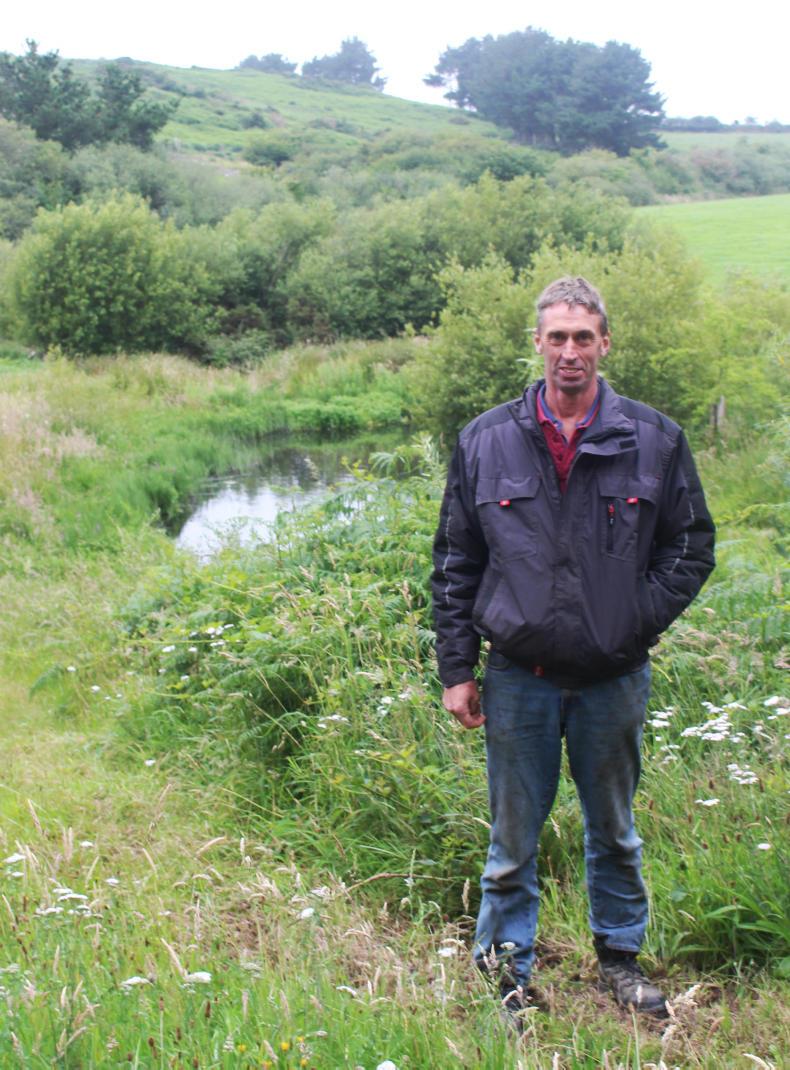
Ned Morrissey in the section of his farm which he converted to a wetland woodland as part of the Dunhill waste water treatment project. \ Donal Magner
He decided to plant in 2007 under the Forest Service Afforestation Scheme. “The 15ac conversion comprises woodlands, wetlands and ponds, and it’s now an attractive place you’d like to go for walks along the river bank and through the forest.”
The forest includes alder – native and Italian – ash, oak and the conifers Scots pine and hybrid larch on the dryer section. He points out how this section of the farm has been transformed from a frequently flooded area to an ecosystem rich in wildlife as well as productive forest.
There is sufficient space to drive a tractor along the river bank to manage the site including maintenance of the wetland and eventually to harvest the commercial trees.
If I were called in
To construct a religion
I should make use of water.
– Philip Larkin, Water, 1954
When David Attenborough says we need to “farm trees”, he adds the proviso that these new plantations should “allow wildlife to pass through natural forest corridors that benefit local communities and economies”.
These new forests should also be “planted on existing cleared land so they don’t replace natural forests”.
The natural forests are long gone in the Anne Valley in east Waterford but trees and woodlands play a major role in this intensively farmed area. Water is the unifying component as the Annestown stream is the corridor that Attenborough might have in mind. It connects wetland, farmland, wildlife habitats, trees, woodlands and the community of Dunhill.
Unlike Philip Larkin’s imagined call to construct a religion, the call in the Anne Valley was to construct – or reconstruct – wetlands, to purify the Annestown stream which was being increasingly polluted up until the early 1990s. This environmental call was answered by Dr Rory Harrington, a scientist and forester who convinced farmers in the catchment that nature rather than costly technology would be the solution to water pollution.
ICWs comprise a series of interconnected wastewater treatment systems or ponds planted with sedges and reeds
In 1992, Harrington proposed transforming water treatment and the ecology of the Dunhill-Anne Valley. Drawing from ecosystem function studies at Yale University and practical experience at Doneraile Park, Co Cork, and his family home farm, he established the integrated constructed wetland (ICW) concept.
ICWs comprise a series of interconnected wastewater treatment systems or ponds planted with sedges and reeds. These purify wastewater and sewage from farms and dwellings before returning it to the Annestown stream.
When I visited Dunhill recently to meet Rory Harrington and Dermot Dunphy, forestry consultant, we met up with farmers Niall Moore, Willie Moore, Eugene Dunphy and Milo Murphy, who outlined the benefits of the ICW system to their farms. Along with other farmers in the area, they faced heavy investment in mechanical water treatment to tackle waste run-off from their lands and farmyards as well as possible fines.
Alternative
The alternative was to work with nature in adopting Harrington’s ICW concept. The farmers in the Anne Valley catchment are intensive dairy, beef, sheep and tillage producers and these enterprises by their nature – and productivity – place huge pressure on the stream and its wetlands.
“Sources of linked polluted water within any catchment need to be tackled by all farmers as the required chain of ICWs is only as strong as its weakest link,” says Harrington.
“Twelve farmers participated and were supported by the Waterford LEADER Partnership, National Parks and Wildlife Service, and the Office of Public Works.” He praises their commitment in realising the project. Today, the ICWs are licensed under the EPA discharge licence system and Irish Water is responsible for their maintenance.

The reprofiled stream, a wooded corridor accessible for tractor-based maintenance of the woodlands and linked wetlands that intercept and treat water run-off from adjacent fields.\ VESI Environmental Ltd
The wetland ponds and their vegetation are central to the ICWs but Harrington and the farmers have ingeniously combined these with a series of forest corridors and small woodlands. These not only act as natural buffers but also enrich the flora and fauna, enhance the landscape and are now used by the public as a recreation and educational resource. He lists off the bird life that has recolonised the wildlife corridor, while salmon and brown trout have returned to the stream.
A scientist and forester with Irish and international experience, Harrington has a global perspective of silviculture. He regards the broadleaf versus conifer and the native versus exotic tree debates as simplistic. He is a realist, and acknowledges the limited range of native tree species in Ireland.
He enthuses on the wide range of species that grow well in Ireland including the exotics Sitka spruce and Douglas fir, and species not widely planted but with potential including Monterey pine, coastal redwood and southern beech.
“Non-native species woodlands are the mainstay of Ireland’s timber industry,” Harrington explains.
The native alder is an ideal riparian tree that suits this area
“They provide both commercial timber crops and surrogate habitats of significant conservation and biodiversity value, if appropriately configured and managed.”
He also recognises the importance of native species such as ash, willow, whitethorn, black poplar and alder that populate the bank of the Annestown stream. “The native alder is an ideal riparian tree that suits this area, but we are seeing even better timber performances from Italian alder on dryer soils,” he maintains.
The wetland forests are designed for access not only for recreation but for tractor-based maintenance and production. The woodlands are not confined to river catchments as blocks of forests dot the surrounding landscape.
Impressive
Dermot Dunphy reels off the names of tree species from the river bank corridor across the landscape to the small blocks of woodlands receding in the distant rolling hills with the assurance of a forester who is involved in compiling Ireland’s “National Forestry Inventory” for the Forest Service.
The species range is impressive and while progressive farmers around Dunhill maximise agricultural production, Dunphy points to spaces left for blocks of oak, Sitka spruce, Douglas fir, hybrid larch and other species.
Rory Harrington stresses that projects such as the Dunhill ICW system and wetland forests don’t require large-scale transfer of agricultural land in providing clean water and climate change mitigation benefits.
“The combined annual wetland carbon dioxide sequestration potential from Ireland’s farmyards alone could be up to 4m tonnes based on no more than 2ha of functional wetland area per farm,” he says, before outlining a number of ICW projects he is developing as senior scientist with VESI Environmental Ltd, the Cork-based company specialising in water and land services.
Creating a farm biodiverse wetland and productive forest environment
Ned Morrissey is one of the 12 farmers in the Anne River catchment who bought into the wetland project. He converted 15 acres of his 100ac lowland sheep farm to (mostly wetland) forestry.
He acknowledges that this is a sizeable proportion of land to transfer to forest. “Most of the forest is located along a valley – a rough, wet, non-productive area that we would never go near,” he explains.
“Access was difficult and it was often flooded.”

Ned Morrissey in the section of his farm which he converted to a wetland woodland as part of the Dunhill waste water treatment project. \ Donal Magner
He decided to plant in 2007 under the Forest Service Afforestation Scheme. “The 15ac conversion comprises woodlands, wetlands and ponds, and it’s now an attractive place you’d like to go for walks along the river bank and through the forest.”
The forest includes alder – native and Italian – ash, oak and the conifers Scots pine and hybrid larch on the dryer section. He points out how this section of the farm has been transformed from a frequently flooded area to an ecosystem rich in wildlife as well as productive forest.
There is sufficient space to drive a tractor along the river bank to manage the site including maintenance of the wetland and eventually to harvest the commercial trees.





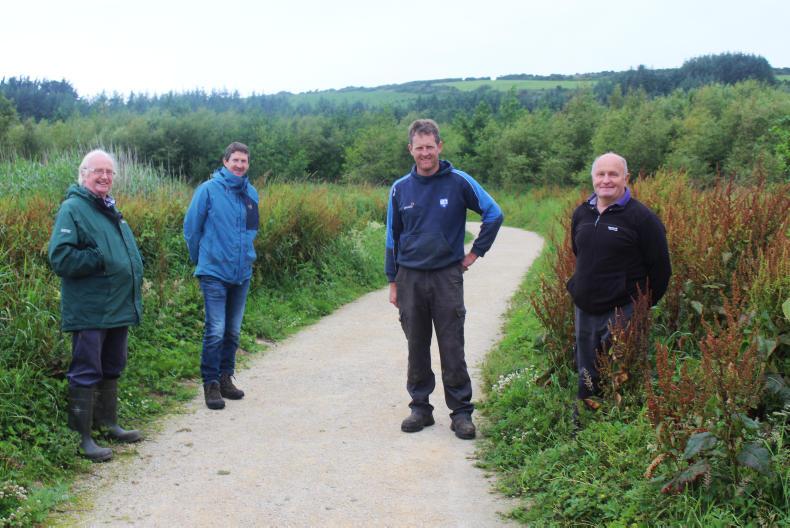

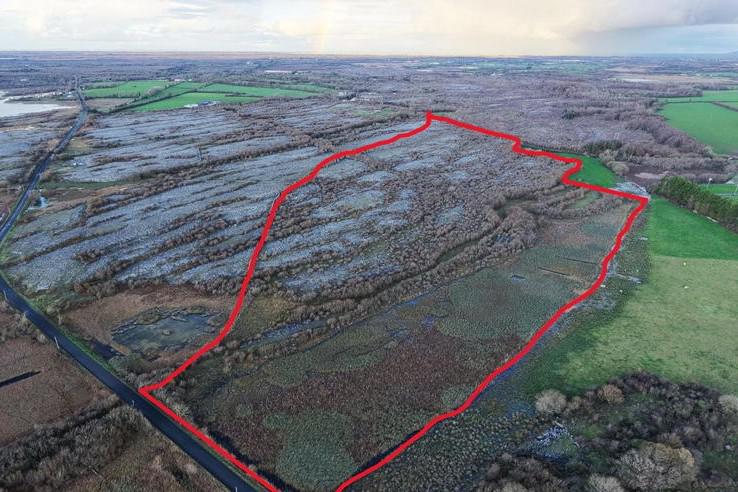

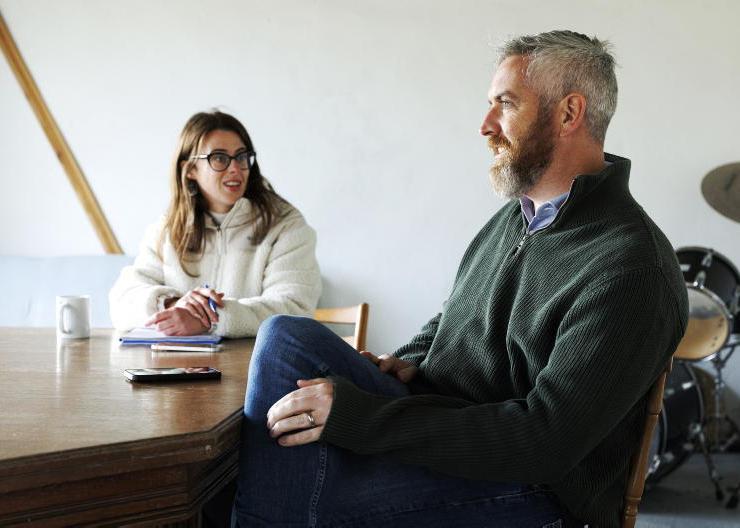

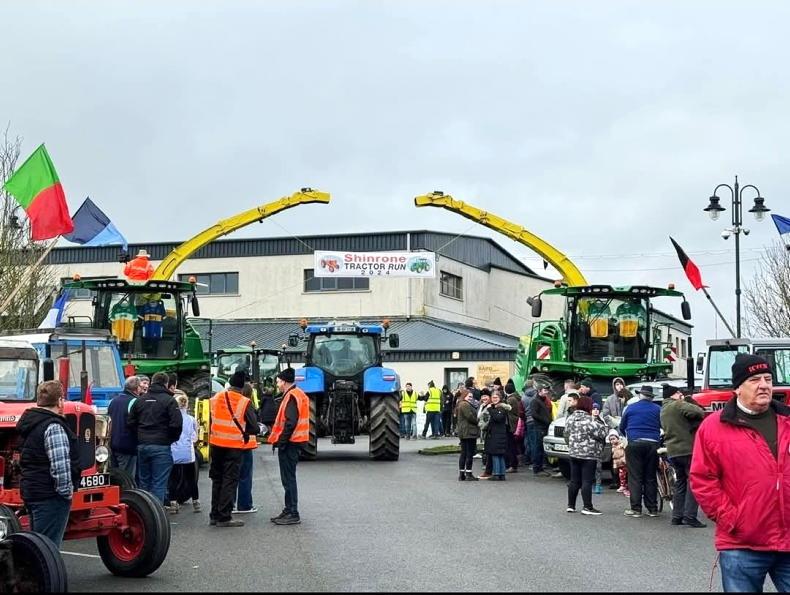
SHARING OPTIONS